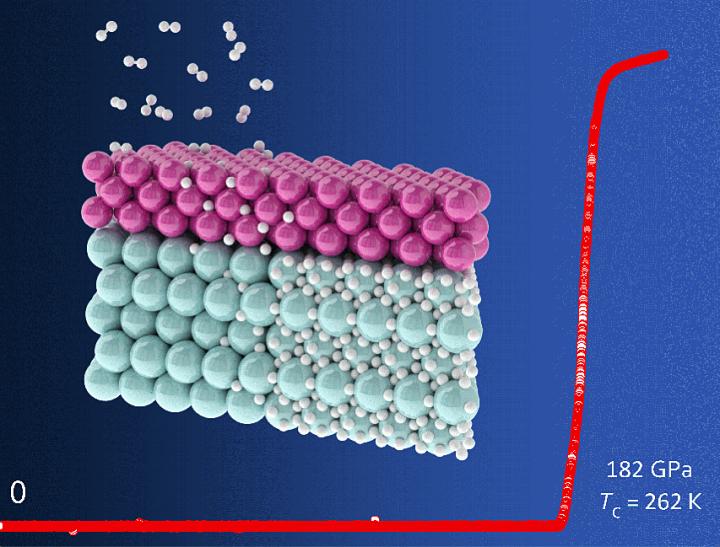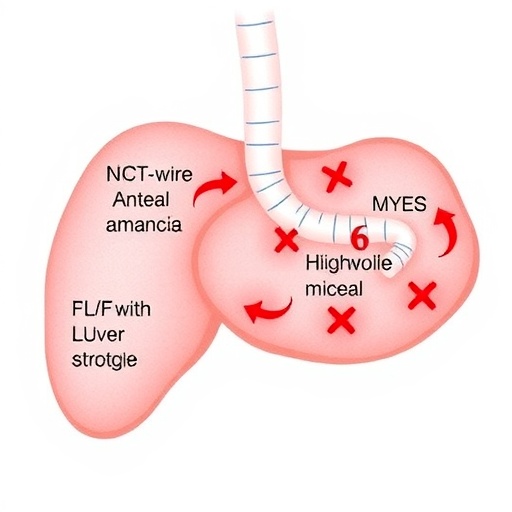University of Rochester researchers reduce the pressure required by separating hydrogen atoms from yttrium with a thin film of palladium

Credit: Ranga Dias lab/University of Rochester
University of Rochester researchers who demonstrated superconducting materials at room temperatures last fall, now report a new technique in the quest to also create the materials at lower pressures.
In a paper published in Physical Review Letters, the lab of Ranga Dias, assistant professor of mechanical engineering and of physics and astronomy, describes separating hydrogen atoms from yttrium with a thin film of palladium.
“This is a completely new technique that nobody has used before for high pressure superhydride synthesis,” Dias says.
Hydrogen rich materials are critical in the quest for room temperature superconductors because “you want stronger bonds and light elements. Those are the two very basic criteria,” Dias says. “Hydrogen is the lightest material, and the hydrogen bond is one of the strongest.”
Palladium is known to be a very good catalyst for “breaking down hydrogen molecules and diffusing them into whatever material you want to study,” Dias says. In this case, a tiny layer of palladium protects the yttrium, a reactive transition metal, from oxidizing, but at same time, breaks down the hydrogen into individual atoms, which are then transported into the yttrium.
This is done inside a diamond anvil, which is used to compress the materials.
The resulting yttrium superhydride is superconducting at 12 degrees Fahrenheit and about 26 million pounds per square inch, still too high for practical applications. But it is a significant improvement over the room temperature materials the researchers reported last fall in Nature.
In that paper, the researchers reporting combining hydrogen with carbon and sulfur, which was superconducting at about 36 million pounds per square inch. (Pressure at sea level is about 15 psi.)
“We will continue to use this new method to synthesize new superconducting materials at ambient pressure,” Dias says.
The researchers used raman spectroscopy, which they believe is more effective than the X-ray diffraction techniques that are traditionally used to measure the behavior of hydrogen atoms.
To validate that, the researchers collaborated with Eva Zurek, professor of chemistry at the State University at Buffalo, who prepared theoretical simulations of how the hydrogen atoms could be expected to behave when transported into the yttrium. Those simulations were in “good agreement” with the lab’s experimental data, Dias says.
Other coauthors on the paper include lead author Elliot Snider ’19 (MS), Nathan Dasenbrock-Gammon ’18 (MA), Raymond McBride ’20 (MS), and Noah Meyers, all of the Dias lab; Xiaoyu Wang of the State University at Buffalo; and Keith Lawlor and Ashkan Salamat of the University of Nevada Las Vegas.
First discovered in 1911, superconductivity gives materials two key properties. Electrical resistance vanishes. And any semblance of a magnetic field is expelled, due to a phenomenon called the Meissner effect. The magnetic field lines have to pass around the superconducting material, making it possible to levitate such materials, something that could be used for frictionless high-speed trains, known as maglev trains.
Superconducting materials could also have applications in medical imaging and scanning techniques such as MRI and magnetocardiography; faster, more efficient electronics for digital logic and memory device technology.
###
The research was supported with funding from the National Science Foundation; the Department of Energy Stockpile Stewardship Academic Alliance Program; the Department of Energy, Office of Science, Fusion Energy Sciences; and the Department of Energy, Office of Basic Energy Sciences.
Media Contact
Bob Marcotte
[email protected]
Original Source
https:/
Related Journal Article
http://dx.




